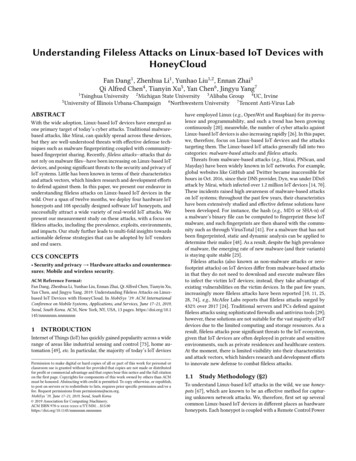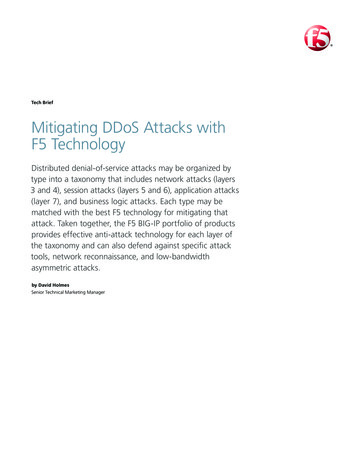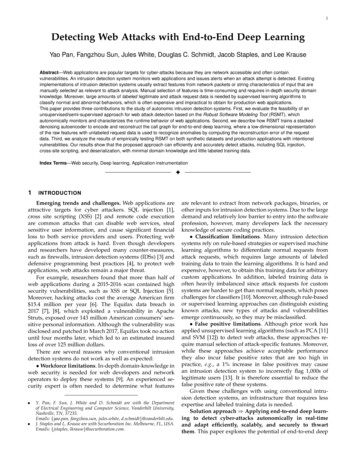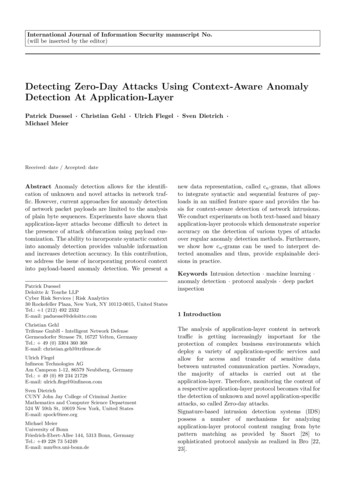
Transcription
International Journal of Information Security manuscript No.(will be inserted by the editor)Detecting Zero-Day Attacks Using Context-Aware AnomalyDetection At Application-LayerPatrick Duessel · Christian Gehl · Ulrich Flegel · Sven Dietrich ·Michael MeierReceived: date / Accepted: dateAbstract Anomaly detection allows for the identification of unknown and novel attacks in network traffic. However, current approaches for anomaly detectionof network packet payloads are limited to the analysisof plain byte sequences. Experiments have shown thatapplication-layer attacks become difficult to detect inthe presence of attack obfuscation using payload customization. The ability to incorporate syntactic contextinto anomaly detection provides valuable informationand increases detection accuracy. In this contribution,we address the issue of incorporating protocol contextinto payload-based anomaly detection. We present aPatrick DuesselDeloitte & Touche LLPCyber Risk Services Risk Analytics30 Rockefeller Plaza, New York, NY 10112-0015, United StatesTel.: 1 (212) 492 2332E-mail: paduessel@deloitte.comChristian GehlTrifense GmbH - Intelligent Network DefenseGermendorfer Strasse 79, 16727 Velten, GermanyTel.: 49 (0) 3304 360 368E-mail: christian.gehl@trifense.deUlrich FlegelInfineon Technologies AGAm Campeon 1-12, 86579 Neubiberg, GermanyTel.: 49 (0) 89 234 21728E-mail: ulrich.flegel@infineon.comSven DietrichCUNY John Jay College of Criminal JusticeMathematics and Computer Science Department524 W 59th St, 10019 New York, United StatesE-mail: spock@ieee.orgMichael MeierUniversity of BonnFriedrich-Ebert-Allee 144, 5313 Bonn, GermanyTel.: 49 228 73 54249E-mail: mm@cs.uni-bonn.denew data representation, called cn -grams, that allowsto integrate syntactic and sequential features of payloads in an unified feature space and provides the basis for context-aware detection of network intrusions.We conduct experiments on both text-based and binaryapplication-layer protocols which demonstrate superioraccuracy on the detection of various types of attacksover regular anomaly detection methods. Furthermore,we show how cn -grams can be used to interpret detected anomalies and thus, provide explainable decisions in practice.Keywords Intrusion detection · machine learning ·anomaly detection · protocol analysis · deep packetinspection1 IntroductionThe analysis of application-layer content in networktraffic is getting increasingly important for theprotection of complex business environments whichdeploy a variety of application-specific services andallow for access and transfer of sensitive databetween untrusted communication parties. Nowadays,the majority of attacks is carried out at theapplication-layer. Therefore, monitoring the content ofa respective application-layer protocol becomes vital forthe detection of unknown and novel application-specificattacks, so called Zero-day attacks.Signature-based intrusion detection systems (IDS)possess a number of mechanisms for analyzingapplication-layer protocol content ranging from bytepattern matching as provided by Snort [28] tosophisticated protocol analysis as realized in Bro [22,23].
2However, the major drawback of signature-based IDSis their reliance on appropriate exploit signatures inorder to provide adequate protection. Unfortunately,keeping signatures up-to-date is a tedious and resourceintensive task given the rapid development of newexploits and their growing variability. This motivatesthe investigation of alternative techniques.Payload-based anomaly detection is capable to instantaneously detect previously unknown application-layerattacks. Unlike signature-based systems which searchfor explicit byte patterns, payload-based anomaly detection systems must translate general knowledge aboutpatterns into a numeric measure of abnormality whichis usually defined by a distance from some modellearned over normal payloads.Thereby, the choice of data representation which isrequired to measure similarity between sequential datastrongly affects the capabilities of an anomaly detectorat hand. Sequential data representations, such as ngrams of payload bytes [25, 34], exhibit superiorprecision at the detection of unknown overflow-basedattacks. However, this type of data representation doesnot adequately account for structural sensitivity neededfor detection of rather inconspicuous looking attackssuch as cross-site scripting (XSS) or SQL injection. Byaccessing protocol context of attack patterns significantimprovements in the detection accuracy of unknownapplication-layer attacks can be achieved [5, 9, 14].In this article, we propose a novel representationof network payloads that integrates protocol contextand byte sequences into an unified feature space andthus, allows for a context-aware detection of networkintrusions. To this end, a protocol analyzer transforms anetwork byte stream into the structured representationof a parse tree. Tree nodes are extracted and insertedas tuples of token/attributes into the cn -gram datastructure, a novel data representation of network trafficthat allows to efficiently combine sequential modelswith protocol tokens. Moreover, explainability and thecapability to visualize suspicious content with respectto protocol context is another advantage of this datastructure over sequential representations.In order to illustrate the effectiveness of theproposed context-aware payload analysis, we conductan extensive experimental evaluation in which cn grams are compared to conventional n-grams in thepresence of a diversity of attacks carrying variouspayloads. In order to point out the strengths of theproposed data representation, attacks not only includebuffer overflows but also web application attacks. Suchattacks, for example SQL injections, XSS injectionsand other script injection attacks, are particularlydifficult to detect due to their variability and theirPatrick Duessel et al.strong entanglement in the protocol framework, whichmakes content analysis based on sequential featuresineffective. Our experiments are carried out on networktraffic containing text-based and binary applicationlayer protocols.The paper is structured as follows: The main contribution of the paper is presented in Section 2 and provides details on a novel data representation for networkpayloads which allows for the computation of contextaware sequential similarity by geometric anomaly detection methods. A comprehensive experimental evaluation of the proposed method on network traffic featuring various application-layer protocols is carried out inSection 3. Related work on content-based anomaly detection and protocol analysis is presented in Section 4.Finally, conclusions and an outline of future work canbe found in Section 5.2 MethodologyThe following four stages outline the essential buildingblocks of our approach and will be explained in detailfor the rest of this section.1. Data Acquisition and Normalization. Inboundpackets are captured from the network, reassembled and forwarded to a protocol analyzersuch as binpac [21] which allows to extractapplication-layer messages from both text-basedand binary protocols. A key benefit of using protocoldissectors as part of data pre-processing is thecapability to incorporate expert knowledge in thesubsequent feature extraction process. Details onprotocol analysis can be found in Section 2.1.2. Feature Extraction. At this stage, byte messagesare mapped into a metric space using datarepresentations and features which reflect essentialcharacteristics of a byte sequence. Our approachallows to combine byte-level and syntax-levelfeatures in an unified metric space. Details ofthe feature extraction process can be found inSection 2.2.3. Similarity Computation. The similarity computation between strings is a crucial task for payloadbased anomaly detection. With the utilization ofvectorial data representations messages can be compared by computing their pairwise distance in thedesignated geometric space. Similarity measures areexplained in Section 2.3.4. Anomaly Detection. In an initial training phasethe anomaly detection algorithm learns a globalnormality model. At detection time a message iscompared to the learned data model and based on
Detecting Zero-Day Attacks Using Context-Aware Anomaly Detection At Application-Layerits distance an anomaly score is computed. Detailson the anomaly detection process can be found inSection 2.4.2.1 Protocol AnalysisNetwork protocol analysis is a useful technique todecode and understand data which is encapsulated byan application-specific protocol. Many application-levelprotocols follow the notion of a common protocol designwhich is reflected in a unified protocol structure [3].The majority of application-level protocols stipulatethe concept of an application session between twoendpoints in which a series of messages is exchangedto accomplish a specific task. Thereby, a protocol statemachine determines the structure of the applicationsession and specifies legitimate sequences of messagesallowed by the protocol. Another essential element of anapplication protocol is the message format specificationwhich defines the structure of an application-layermessage. A message format specifies a sequence offields and their corresponding notion. The syntax of anapplication-layer protocol can usually be specified by anaugmented Backus-Naur-Form which is used to expressformal grammars that generate context-free languages.Application protocol analyzer, such as binpac [21],allow to transform re-assembled application-layermessages into a structured data representation,e.g.parse trees, which entangle transferred user datawith syntactic aspects of the underlying applicationlayer protocol. In this contribution, we focus onthe analysis of message format specifications and donot address the problem of inferring protocol statemachines which has been sufficiently addressed in thepast. The proposed method is demonstrated using thetwo application-layer protocols HTTP and RPC whichare explained in detail in the following sections.2.1.1 Hyper-Text Transfer ProtocolThe Hyper-Text Transfer Protocol (HTTP) is one of themost popular text-based application-layer protocols.An example of a typical HTTP request is given below.Control characters are shown as ’.’.GET /search?q network security&gws ssl&pr 20 HTTP/1.1.Host: www.google.de.User-Agent: Mozilla/5.0 (X11; .Linux x86 64; rv:12.0) Gecko/20100101 Firefox/12.0.Accept: text/html,application/xhtml xml,application/xml;q 0.9,*/*;q 0.8.Accept-Language: en-us,en;q 0.5.Accept-Encoding: gzip, deflate.Connection: keepalive.The GET request contains CGI parameters aswell as common HTTP headers. With the protocol3specification at hand a protocol analyzer generates astructured representation of the request sequence whichis typically realized by parse trees. An example of acorresponding parse tree is shown in Fig. 1(a). Thetree consists of non-terminal nodes as well as preterminal and terminal nodes. However, due to thelimited complexity of the underlying HTTP grammar,relevant information resides at the pre-terminal andterminal level only. Therefore, the tree can be shrunkand converted into a set of key/attribute tuples.Thereby, each pre-terminal node label serves as aunique protocol context key whereas the associatedattribute is assembled from connected terminal nodes.2.1.2 Remote Procedure CallsA more opaque application-layer protocol is providedby Remote Procedure Call (RPC). A significant partof the Microsoft Windows architecture is composed ofservices (e.g. DNS, DHCP, DCOM) that communicatewith each other in order to accomplish a particular task.Microsoft RPC is a widely used binary application-layerprotocol and represents a powerful technology which isutilized by a multitude of services to access functionslocated at foreign address spaces.In order to invoke methods remotely, RPC requiresto establish a session context. By submitting a BINDrequest the client initiates an RPC session in which theendpoint mapper interface is requested to bind to thedesired RPC interface. An example of a BIND request isshown below:0000001000200030004005 00 0b A 03 10 00 00 00 78 00 28 00 02 00 00 00d0 16 d0 16 92 bc 00 00 01 00 00 00 01 00 B 01 00a0 01 00 00 00 00 00 00 c0 00 00 00 00 00 00 46 C00 00 00 00 04 5d 88 8a eb 1c c9 11 9f e8 08 002b 10 48 60 02 00 00 00 D .The most important fields of a BIND request arehighlighted and include protocol data unit type (A)as well as RPC session information. Each session isessentially defined by a context identifier (B) and auniversally unique identifier (UUID) which correspondsto the requested RPC interface (C). In order to allowfor transfer encoding negotiation, the client providesa coding scheme (D) to the server for each sessionrequested.The endpoint mapper resolves and returns the endpoint(TCP port) in response to the interface request. Oncethe client obtains the endpoint it connects to theinterface and invokes the desired method by sendinga CALL request.0000001005 00 00 A 03 10 00 00 00 20 03 00 00 02 00 00 00 E08 03 00 00 01 00 B 04 00 F 05 00 07 00 01 00 00 00
4Patrick Duessel et al. request header pdu-type . call-id 0002 00 00 00 stub uuid* opnum A0 01 00 0000 00 00 00C0 00 00 0000 00 00 4604 0005 00 07 00DCOM CALL in RPCPayload pdu-type 0040005000600070 params 00 00 00 00 23 f7 4c be d7 2c 03 4c ad ae 70 99dc 31 2e 80 00 00 00 00 00 00 00 00 00 00 02 00d8 02 00 00 d8 02 00 00 4d 45 4f 57 04 00 00 00a2 01 00 00 00 00 00 00 c0 00 00 00 00 00 00 46 G38 03 00 00 00 00 00 00 c0 00 00 00 00 00 00 4600 00 00 00 a8 02 00 00 a0 02 00 .00The header essentially specifies a call identifier (E), asession context identifier (B), a method identifier (F)and payload which contains arguments expected bythe method. Since the context identifier (B) refers toan active application session in which the client hasbound to an interface already the UUID is not explicitlytransmitted in a CALL request but instead, referencedby the corresponding context identifier.With the protocol specification at hand the protocolanalyzer produces a parse tree which is shown inFig. 1(b). In this particular example, RPC is used tocall the ISystemActivator interface in order to requestinstantiation of a class which is identified by the UUID(G) in the parameter section of the RPC request.Certainly, method call details can only be extractedfrom the request if an appropriate RPC stub dissectoris in place which is able to analyze RPC payloadaccording to a list of known core interfaces and methoddeclarations. For our considerations, Wireshark’s [35]DCE/RPC dissection module is used which allowsfor concise and automatic parameter value extractionof functions that are declared by well-known RPCinterfaces (e.g. LSARPC and SRVSVC). cause-id 23 F7 4C BED7 2C 03 4CAD AE 70 99DC 31 2E 80 if-id .A2 01 00 0000 00 00 00C0 00 00 0000 00 00 46identifieris request Fig. 1 Generated parse trees representing application-layer protocol requests header 0030.(b) RPC/DCOM request parse tree ( contextdynamically replaced by the corresponding UUID)(a) HTTP request parse tree0020 orpcthis version obj-id fct-id orpcthis version opcode version cause-id params CLSID sec-level fct-id application payloads X into a N -dimensional metricspace - in the following referred to as feature space F over real numbers:00 00 00 0000 00 00 0000 00 00 0000 00 00 00B8 4A 9F 4D1C 7D CF 1186 1E 00 20AF 6E 7C 5700 00 00 000005 00 01 00F1 59 EB 61FB 1E D1 11BC D9 00 6097 92 D2 6C02 00 00 1000 00 00 0000 00 00 0000 00 00 01x 7 φ(x) (φ1 (x), φ2 (x), . . . , φN (x)),02 00 00 0000 00 00 0000 00 00 00C0 00 00 0000 00 00 46(1)where φi (x) R 0 represents the value of the ith feature. Thereby, the sole choice of the mappingfunction φ(x) provides a powerful instrument totransform data into a representation that is suitablefor a given problem.In this section we describe feature mappings basedon different types of features. While protocol analysissuggests to extract features from tree structures suchas parse trees, the detection of suspicious byte patternsfavors the extraction of sequential features. Once afeature space has been designed, there are severalfeature embeddings to chose from. Common featureembeddings include binary, count as well as frequencyrepresentations of individual features.Syntax Features. The syntactic structure of transferredapplication-level payload can be extracted by conducting protocol analysis which eventually allows to generate parse trees. An intuitive way to characterize aparse tree structure is to consider each node independently of its syntactic context, i.e. predecessors as wellas successors. The following feature map can be usedto determine structural similarity between sequences:φ : s 7 (φτ (s))τ T F , 2.2 Feature ExtractionApplication payload is characterized by sequentialdata which is not applicable for learning methodsthat operate in metric spaces. Therefore, featureextraction must be performed in order to mapsequences into a metric space in which similaritybetween vectorial representations of sequences can becomputed. Formally, a feature map φ : X 7 RN canbe defined which maps a data point in the domain ofwhere T denotes the set of all possible unique subtrees.The mapping function φ(s) is defined as follows:(1, t {τ T n(τ ) 1}φt (s) (2)0, otherwise,where n(τ ) is a function which returns the numberchild nodes attached to a node τ . Using this mapping,each dimension in F corresponds to a binary featureindicating the presence of a particular pre-terminalnode t in the actual parse tree of a sequence s. For
Detecting Zero-Day Attacks Using Context-Aware Anomaly Detection At Application-Layer5k bitthe rest of this paper, the set of pre-terminal nodesas a representation of an application-level message isreferred to as bag-of-token ww.2er6er2ty6deH1H2H6c₂- gram histogramer0164 bitn-gramerMethodPath H(s)HeadersCGI RequestParamsLineContextBodySequential Features. An intuitive data representationat byte-level involves the extraction of uniquesubstrings by moving a sliding window of length nover a sequence. The resulting set of feature strings arecalled n-grams. Each sequence s is embedded into a ndimensional metric space F where F Rn , using thefollowing feature map:m-k bit φ : s 7 (φw (s))w Σ n F ,Fig. 2 cn -grams: context-aware sequential data representationwhere Σ n refers to the set of all possible strings w oflength n induced by an alphabet Σ.Context-aware Sequential Features. Protocol dissectionallows to attach syntactic information to sequentialfeatures. By introducing a novel data representation,so called contextual n-grams (cn -grams), syntacticfeatures can be combined with sequential features inan unified feature space using the feature mapping φ(s)below.φ : s 7 (φw,τ (s))wτ Σ n F ,where Σ n refers to the set of all possible strings wτ oflength n induced by an alphabet Σ and τ T refers toa subtree in the set of all possible subtrees. A schematicillustration of cn -grams is shown in Fig. 2.The cn -gram data structure allows to efficiently storen-grams along with syntactic labels. Each entry inthe data structure has a unique hash value. The hashvalue encodes both syntactic context and sequentialinformation represents a cn -gram. The syntactic labelinformation (i.e. pre-terminal nodes from the parsetree) is encoded using the first k-bits of the CPU’sregister size m, whereas the remaining m k bitsare used to encode the actual n-gram (n b m k8 c)observed in the terminal string attached to a preterminal node. As a result, a particular n-gram isallowed to be contained in terminal strings attachedto different pre-terminal nodes which represents anextension to the regular definition of n-grams outlinedin 2.2.In the example shown in Fig. 2 extracted HTTP preterminal nodes are encoded and combined with n-gramsfrom parsed terminal strings represented as cn -gram.Finally, the set of cn -grams is convoluted in a jointhistogram H.2.3 Similarity MeasureOnce a sequence is mapped into a feature space F akernel function k : X 2 R can be applied to determinepairwise similarity between data points {x1 , ., xn } X . Thereby, the type of kernel function entails animplicit mapping of a data point in F into a possiblyeven higher dimensional feature space F which could,in some situations, facilitate the learning process.In this section we describe two different kernel functionsthat are most widely used in various applicationdomains, the Linear Kernel and the Radial BasisFunction Kernel (RBF).Linear Kernel. The linear kernel is defined by a dotproduct between two vectors x and y and is used todetermine similarity between data points which arelinearly mapped into F:k(x, y) hφ(x), φ(y)inP φi (x)φi (y).(3)i 1With regard to network security, the major benefit ofthis particular kernel becomes immediately clear. Dueto the bijective mapping, a pre-image of every datapoint in the feature space F exists which allows todirectly deduce differences in features located in F .Although it seems to quickly become computationalunfeasible to compute dot products over sequentialfeatures the utilization of efficient data structures suchas suffix trees or hash tables allow to compute thesimilarity k(x, y) in O( x y ) time [29, 32]. The dotproduct is of particular mathematical appeal becauseit provides a geometric interpretation of a similarityscore in terms of length of a vector as well as angle and
6Patrick Duessel et al.(4)RBF-Kernel. A more complex similarity measure isprovided by the RBF-Kernel which implicitly mapsdata points into a feature space F which is non-linearlyrelated to the input space. The RBF-kernel is definedas follows: kx yk2k(x, y) exp ,2σ 2(5)where σ controls the width of the gaussian distributionand directly affects the shape of the learner’s decisionsurface. While a large σ results in a linear decisionsurface which indicates a linearly separable problem,a small value of σ generates a peaky surface whichstrongly adapts to the distribution of the data in F .The interpretation of RBF-kernel values is non-trivialbecause, unlike linear kernel functions, an RBF-kernelimplicitly maps data points from the input space to aninfinite dimensional feature space F . As an example,consider two data points x, y R2 , where x (x1 , x2 ),y (y1 , y2 ), the RBF-kernel can be re-formulated asan infinite sum of inner products over features in inputspace using Taylor series as shown in Eq.( 6). 2 kx yk , (x1 y1 )2 (x2 y2 )2 , x21 2x1 y1 y12 x22 2x2 y2 y22 , kxk2 · exp kyk2 · exp 2xT y , P Tn exp kxk2 · exp kyk2 · n 0 (2xn!y) .k(x, y) exp exp exp exp(6)2.4 Anomaly DetectionThe problem of anomaly detection can be solved mathematically considering the geometric relationship between vectorial representations of messages. Althoughanomaly detection methods have been successfully applied to different problems in intrusion detection, e.g.identification of anomalous program behavior [e.g. 7, 8],anomalous packet headers [e.g. 17, 19] or anomalousnetwork payloads [e.g. 12, 25, 26, 33, 34], all methodsR2 CminR Rξ RnnXξii 1(7)subject to: φ(xi ) θ 2 R2 ξi ,ξi 0.By minimizing R2 the volume of the hypersphere isminimized given the constraint that training objects arestill contained in the sphere which can be expressed bythe constraint in Eq.(7).SVM Contour Plot [kernel linear]SVM Contour Plot [kernel rbf, sigma 5]4.54.54046 0.053.53.5 0.1433 0.152.522feature #2deucl (x, y) kx yk2q k(x, x) k(y, y) 2k(x, y).share the same concept – anomalies are deviations froma model of normality – and differ in concrete notions ofnormality and deviation. For our purpose we use theone-class support vector machine (OC-SVM) proposedin [31] which fits a minimal enclosing hypersphere tothe data which is characterized by a center θ and aradius R. Mathematically, this can be formulated as aquadratic programming optimization problem:feature #2distance between two vectors. Therefore, the Euclideandistance deucl (x, y) can be easily derived from the abovekernel formulation:2.5 0.2201.5 0.251.51 20.51 0.30.5 0.35 400 0.400.511.522.5feature #133.544.5(a) Linear Kernel00.511.522.5feature #133.544.5(b) RBF KernelFig. 3 Anomaly detection using one-class support vectormachine with linear and non-linear decision functions. Supportvectors are shown with red edging.A major benefit of this approach is the control ofgeneralization ability of the algorithm [20], whichenables one to cope with noise in the training data andthus dispense with laborious sanitization, as proposedby Cretu et al. [2]. By introducing slack variables ξiand penalizing the cost function we allow the constraintto be softened. The regularization parameter C 1N ν controls the trade-off between radius and errors(number of training points that violate the constraint)where ν can be interpreted as a permissible fractionof outliers in the training data. The solution of theoptimization problem shown in Eq. (7) yields twoimportant facts:P1. The center θ αi φ(xi ) of the sphere can beiexpressed as a linear combination of training points.2. Each training point xi is associated with a weightαi , 0 αi C, which determines the contributionof the i-th data point to the center and revealsinformation on the location of xi . If αi 0 then
Detecting Zero-Day Attacks Using Context-Aware Anomaly Detection At Application-Layerxi lies in the sphere ( xi c 2 R2 ) and the datapoint can be considered as normal. In constrast,if αi C xi can be interpreted as an outlier( xi c 2 R2 ). In both cases data points areexcluded from the model of "normality". Thus, onlythose training points yielding 0 αi C arelocated on the surface of the sphere ( φ(xi ) θ 2 R2 ) and thus, define the model of normality asillustrated in Fig. 3. These particular points areknown as support vectors.3. The radius R which is explicitly given by thesolution of the optimization problem in Eq. (7)refers to the distance from the center θ of the sphereto the boundary (defined by the set of supportvectors) and can be interpreted as a threshold fora decision function.Finally, having determined a model of normality theanomaly score Sz for a test data point z can be definedas the distance from the center in the feature space:Sz φ(z) θ 2P (φw (z) θw )2w A P(φw (z) nP(8)αi φw (xi ))2i 1w APP k(z, z) 2 αi k(z, xi ) αi αj k(xi , xj ),ii,jwhere the similarity measure k(x, y) between twopoints x and y defines a kernel function as introducedin Section 2.3. Depending on the similarity measureat hand data models of different complexity canbe learned. For example, as shown in Fig. 3(a)the application of a linear kernel always results inan uniform hypersphere. Thus, the resulting modelprovides a rather general description of the data.However, if data happens to follow a multi-modaldistribution the risk of absorbing outliers in lowdensity regions of the hypersphere might increase.On the contrary, the utilization of an RBF-kernelallows to adopt the distribution characteristics ofthe data resulting in more complex data models asshown in Fig. 3(b). Of course, the downside of thesekind of measures is their lack of interpretability asdata points are implicitly mapped into an infinitedimensional feature space in which the identificationof individual feature contributions to the overalldissimilarity between two data points becomes difficult(c.f. Section 2.3).72.5 Feature VisualizationSo far, we have discussed how payloads are extractedand mapped into a geometric space in which anomalydetection is carried out to identify deviations from apreviously learned model of normality. At this pointthe following question might arise: why is a datapoint considered as an anomaly and what constitutesthe anomaly? In this section, we derive a featurevisualization for payload-based anomaly detectionwhich allows to trace back an anomaly to individualfeatures in the payload and thus, provide a techniquethat not only helps to understand the reason for ananomaly but also means to localize suspicious pattern.Geometrically, a feature can be considered relevant ifit has a significant impact on the norm of a vector.Consequently, the anomaly score S(z) can be expressedas a composition of individual dimensions of R A as shown in Eq. 8. We refer to δz (φw (x) θ)2w A as feature differences, an intuitive visualizationtechnique to explore sequential disparity which hasbeen originally introduced to determine discriminatingq-grams in network traces [25]. The entries of δz reflectthe individual contribution of a string feature to thedeviation from normality represented by θ.While feature differences provide sufficient meansto visualize anomalous network features, a securitypractitioner might also be interested to directlyinspect the portions of the payload that constitute ananomaly. Therefore, the concept of feature differencesis incorporated into a method known as featureshading [27]. The idea of feature shading is to assigna number mj R to each position j in a payloadreflecting its deviation from normality. As a result, thepayload can be overlaid with a color shading accordingto the amount of deviation at a particular position.Considering the generic definition of string features S,each position j in the payload can be associated withmultiple feature strings. Hence, a set Mj can be definedwhich contains all strings s matching a position j of apayload z:Mj {z[i, ., i s ] s s S} j k 1 i j (9)where z[i, ., i s ] denotes a substring of length k inz starting at position i . By using Mj the contributionmj of position j to an anomaly score can be determinedas follows:1 Xmj θs2 .(10) Mj s MjAn abnormal pattern located at j corresponds to lowfrequen
Detecting Zero-Day Attacks Using Context-Aware Anomaly Detection At Application-Layer Patrick Duessel · Christian Gehl · Ulrich Flegel · Sven Dietrich · .

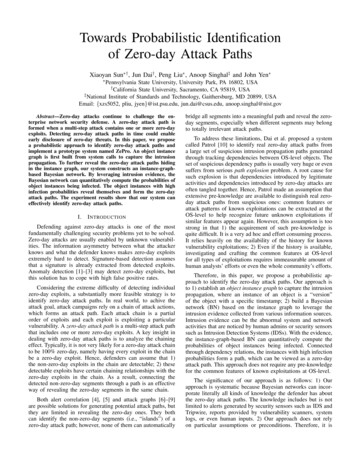
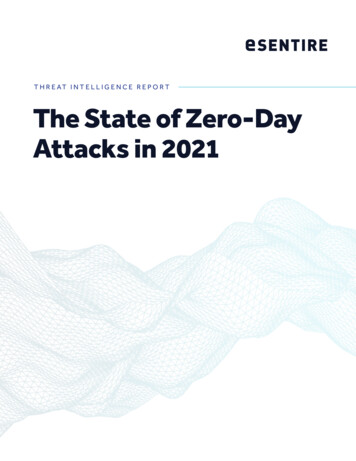
![Welcome [dashdiet.me]](/img/17/30-day-weight-loss-journal.jpg)
